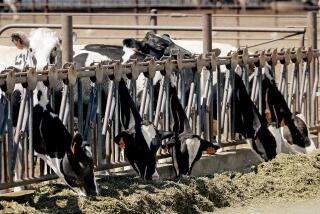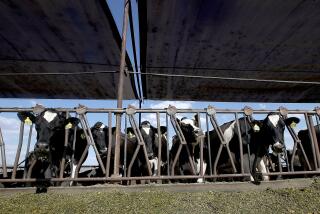Cheese race is fizzling out
Cheese heads donât need to be bleu: Experts say predictions that California will soon overtake Wisconsin as the nationâs top cheese producer are unlikely to come true.
The Golden State and its happy cows gained quickly on Wisconsin in the last decade, but plants in California are maxing out while efforts to boost production in Wisconsin are paying off, said Dick Groves, longtime owner of trade publication Cheese Reporter in Madison, Wis.
Groves helped spark the friendly competition between the states 10 years ago with an editorial that predicted California would overtake Wisconsin in cheese production by 2005. He later amended it to 2010 and then, last month, to ânot any time soon.â
New numbers showing a growing gap between Wisconsin and California prompted Groves to abandon his earlier prediction.
âCheese production in the two states moved in opposite directions -- Wisconsinâs went up and Californiaâs went down,â he said.
About half of the 9.7 billion pounds of cheese made in the U.S. comes from the two states, according to the National Agricultural Statistics Service. Production has grown much more rapidly in California in the last decade, with large plants opening year after year.
Wisconsinâs lead in annual cheese production shrank to about 164 million pounds last year, according to the service. Last July, California came within less than 6 million pounds of Wisconsin in monthly production.
But then the gap started growing again, reaching 30 million pounds in March.
The quick shift is partly attributed to two plants closing in California last year, while two opened in Wisconsin this year, Groves said.
In California, Dairy Farmers of America closed an American cheese plant in Corona, saying it was unprofitable, and Lactalis USA Inc. closed a specialty cheese plant in Turlock.
Meanwhile, Foremost Farms USA idled a plant in Waumandee in western Wisconsin in January 2007, retooled it to make a premium type of cheddar and reopened it in March. The temporary shutdown was ânot insignificantâ in terms of the stateâs cheese production, Foremost Farms spokeswoman Joan Behr said.
Also in March, BelGioioso Cheese Inc. opened its fifth plant in Wisconsin.
California now has 61 cheese plants compared with Wisconsinâs 124. The Golden Stateâs plants are larger, but theyâre pretty much operating at full capacity while Wisconsinâs could probably make a bit more, federal and state agricultural officials said.
That means California would have to add plants to move ahead in the race for the title of Big Cheese. But more new plants are opening in places such as Idaho and the Texas panhandle, which have growing dairy farms and lower costs, said economist Don Blayney of the Economic Research Service in the U.S. Department of Agriculture.
Companies have struggled in recent years to build new plants in California, where the permit process can take four to six years, said Michael Marsh, chief executive of the Western United Dairymen, which represents milk producers in the Golden State.
Cheese makers in California also must contend with opposition from environmental groups and, if they do get a plant open, high workersâ compensation costs, Marsh said. âIt is a challenge for us. The state of California really has to make our state attractive to businesses to locate here.â
Wisconsin has worked to increase its milk supply after cheese makers said they needed about 15% more milk than they had, said Will Hughes, agricultural development administrator. The state has recruited farmers, encouraged them to add cows and provided incentives for them to install newer, more efficient equipment. The effort has paid off with renewed investment from firms such as BelGioioso.
Wisconsin cheese makers and agricultural officials also emphasized that they werenât looking to make more cheese but better cheese. Whereas Californiaâs plants tend to make large quantities of a few kinds, Wisconsin companies have focused on developing a variety of specialty cheeses, such as pesto Jack or Asiago, that command higher prices.
The state recently announced that specialty cheeses now account for 16% of Wisconsinâs production, and two more specialty cheese plants will open in the next few weeks.
âI always say this is not a race with California to be No. 1 in producing cheese,â Hughes said, âalthough not anyone in Wisconsin is going to want to give that up.â
More to Read
Inside the business of entertainment
The Wide Shot brings you news, analysis and insights on everything from streaming wars to production â and what it all means for the future.
You may occasionally receive promotional content from the Los Angeles Times.










